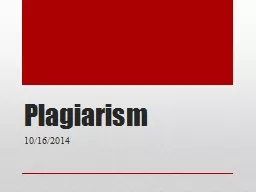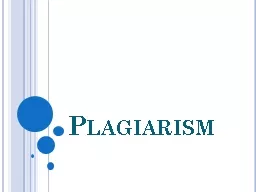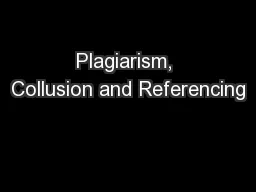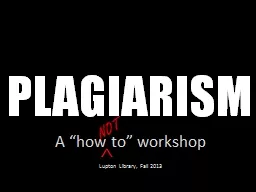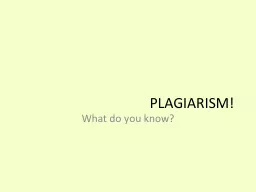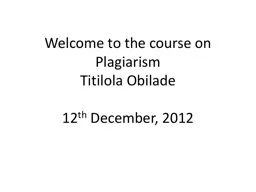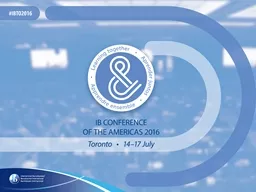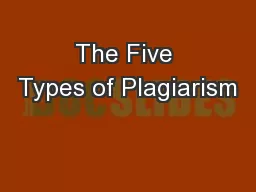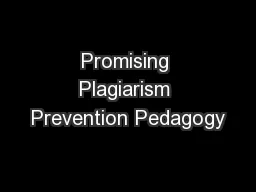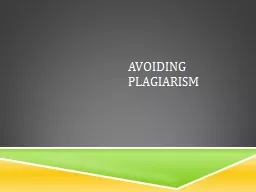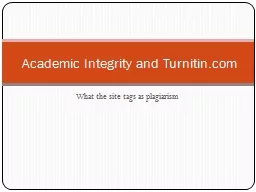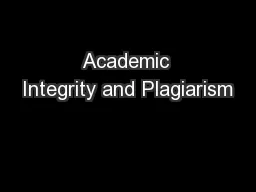PPT-Plagiarism
Author : conchita-marotz | Published Date : 2015-12-01
10162014 Inappropriate Paraphrasing Original source text From time to time this submerged or latent theater in Hamlet becomes almost overt It is close to the surface
Presentation Embed Code
Download Presentation
Download Presentation The PPT/PDF document "Plagiarism" is the property of its rightful owner. Permission is granted to download and print the materials on this website for personal, non-commercial use only, and to display it on your personal computer provided you do not modify the materials and that you retain all copyright notices contained in the materials. By downloading content from our website, you accept the terms of this agreement.
Plagiarism: Transcript
10162014 Inappropriate Paraphrasing Original source text From time to time this submerged or latent theater in Hamlet becomes almost overt It is close to the surface in Hamlets pretense of madness the antic disposition he puts on to protect himself and prevent his antagonists from plucking out the heart of his mystery It is even closer to the surface when Hamlet enters his mothers room and holds up side by side the pictures of the two kings Old Hamlet and Claudius and proceeds to describe for her the true nature of the choice she has made presenting truth by means of a show Similarly when he leaps into the open grave at Ophelias funeral ranting in high heroic terms he is acting out for Laertes and perhaps for himself as well the folly of excessive melodramatic expressions of grief. Areas to be covered in this workshop:. What is plagiarism?. How to avoid plagiarism using referencing. Referencing: voices in academic writing. Referencing conventions: Harvard on-line. Strategies to avoid plagiarism. Why a Lecture?. Goals for this course include learning how to understand original sources and write about them in your own . words.. Committing plagiarism defeats the purpose of writing assignments. Students who plagiarize are not learning from the assignment.. In academic writing you need. to show that you have researched your subject. to acknowledge the sources you have used to avoid the charge of plagiarism. to ensure that it is your own work written in your own words avoiding collusion. A “how to” workshop. Lupton Library, Fall 2013. NOT. ^. Stealing?. WHAT IS PLAGIARISM?. Plagiarism is the act of presenting another person’s words, work, or ideas as if they are your own.. It’s fraud. Not theft.. What do you know?. Has this student plagiarized? . One could argue that the city of Las Vegas, Nevada, is a metaphor of our national character and aspiration, with its symbol of a thirty-foot-high cardboard picture of a slot machine and a chorus girl.. Dr Cordelia Beattie. School Academic Misconduct Officer. . Plagiarism:. . . Plagiarism:. . Hard to Spell, Easy to Do. . Plagiarism:. . Hard to Spell, Easy to Do. Plagiarism is a . SERIOUS ACADEMIC. Titilola. . Obilade. 12. th. December, 2012. Outline. Shared Objective. Reflections. Definition of Plagiarism. Four Authentic Examples of Plagiarism. Live Audio Chat. Assessment. The outline is an advance organizer informing students of what to expect in the lesson on plagiarism.. Workshop and Powerpoint © Catherine Bacque. catherine.bacque@tdsb.on.ca . eyebeebacque@gmail.com. What is Plagiarism?. The IB Position Paper, . Academic Honesty in the IB (Jude Carroll, 2012), . uses the following definition from The International Centre for Academic Integrity:. How to Understand and Avoid Academic Dishonesty. Adapted . by Professor Foss from Theresa . Waliezer’s. in-class presentation. Presenting another’s original thoughts or ideas as your own. Using another’s exact words without . Dr. Robert . Tindol. Shantou University. March 5, 2011. Plagiarism can have serious consequences. http://www.nytimes.com/2011/03/02/world/europe/02germany.html?_r=1&ref=world. What is Plagiarism. Sherry Wynn Perdue. Director, Oakland University Writing Center. 212 . Kresge. Library. wynn@oakland.edu. This presentation is available . at . http://www.oakland.edu/ouwc/presentations. /. Beyond Policies. Things That Should Go Without Saying. There are extreme forms of plagiarism that should be immediately obvious as cheating, but just to be safe, I’m listing them here.. Making up, altering, or forging information is absolutely not permitted on assignments.. Academic Integrity and Turnitin.com. What is Turnitin.com?. Turnitin. is an internet-based plagiarism-prevention service. . Turnitin's. Originality Check helps teachers check students' work for . improper citation . Ms Erika Gavillet. Dr Richy Hetherington. Do you agree to take part?. Yes. No. I don’t know yet. Which of the following professional bodies are you a member of. General Medical Council. The Health Professions Council.
Download Document
Here is the link to download the presentation.
"Plagiarism"The content belongs to its owner. You may download and print it for personal use, without modification, and keep all copyright notices. By downloading, you agree to these terms.
Related Documents

